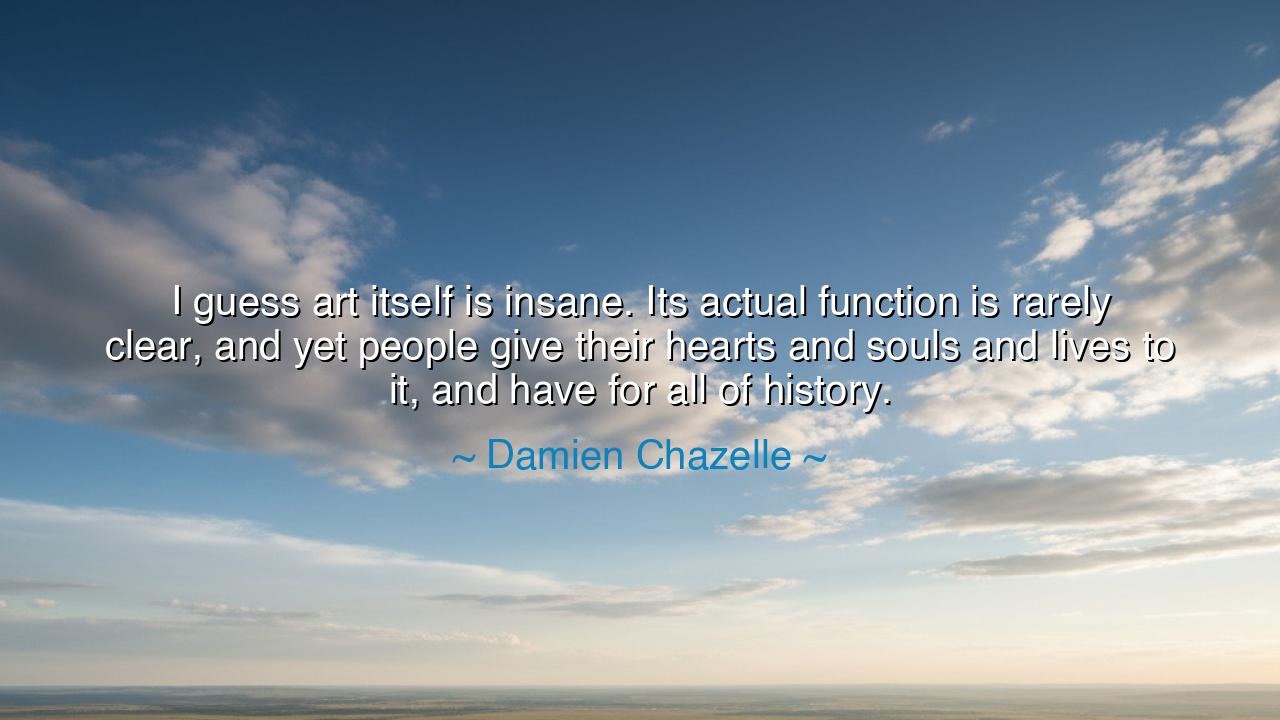
I guess art itself is insane. Its actual function is rarely
I guess art itself is insane. Its actual function is rarely clear, and yet people give their hearts and souls and lives to it, and have for all of history.






In the words of Damien Chazelle, the visionary filmmaker who captured both the ecstasy and agony of artistic pursuit, we find a confession wrapped in wonder: “I guess art itself is insane. Its actual function is rarely clear, and yet people give their hearts and souls and lives to it, and have for all of history.” These words are both lament and revelation. They speak to the ancient madness of creation—the fire that consumes without reason, that drives humanity to carve beauty from chaos, to seek transcendence in sound, color, and form, even when the world offers no explanation for why. Art, Chazelle tells us, is not logic—it is longing made visible. It is the most human kind of insanity, and the most divine.
From the dawn of civilization, the artist has stood apart—neither priest nor warrior, but something in between. In caves lit by flickering flame, our ancestors painted herds of bison on stone walls, though no one commanded them to, though no reward awaited them beyond the quiet satisfaction of expression. What compelled them? Not survival, not duty—something deeper, older, and unnameable. The same spirit moved through Michelangelo, who lay on his back for years beneath the ceiling of the Sistine Chapel, painting the breath of God into Adam’s form; it burned within Beethoven, who composed symphonies he could no longer hear. This is the insanity of art—to strive for perfection knowing it can never be reached, to chase an invisible muse through darkness, to suffer and yet to love the suffering for what it creates.
When Chazelle speaks of art’s “unclear function,” he echoes the philosophers of old who asked: what purpose does beauty serve? Plato saw art as imitation of the divine, a shadow of the ideal. Aristotle said it purified the soul through catharsis, a cleansing of emotion. Yet even they, the wisest of their time, could not fully define why art grips the heart as it does. The truth, perhaps, lies beyond definition. The function of art is to awaken the spirit—to make us feel, to remind us of the sacred mystery of being alive. And though this function cannot be measured, it is the pulse beneath all creation, the heartbeat of human history.
There is a story of Vincent van Gogh, the painter of madness and light. He lived in torment, misunderstood and penniless, yet his canvases burned with the intensity of stars. “I put my heart and soul into my work,” he said, “and I have lost my mind in the process.” Van Gogh’s life mirrors Chazelle’s insight: that to serve art is to surrender to something larger than reason. The world may call it madness—but it is a holy madness, one that transcends logic to touch eternity. Long after his death, his paintings—Starry Night, Sunflowers, The Bedroom—continue to speak, proving that the artist’s sacrifice was not in vain. For though art may not have a clear purpose, its power is undeniable: to move hearts across centuries, to breathe immortality into mortal hands.
And yet, there is danger in this devotion. Chazelle, who explored this truth in films like Whiplash and La La Land, knows the double-edged nature of artistic obsession. The artist who gives “heart and soul and life” to their craft walks a narrow path between creation and destruction. Like Icarus, they fly toward the sun of inspiration, risking the fall for a glimpse of the divine. The ancients would have called this hubris, but Chazelle recognizes it as the price of passion. To create is to risk breaking oneself, yet not to create is a slower death. Thus, the artist lives perpetually between sanity and surrender.
The lesson, then, is not to flee from this madness but to honor it wisely. To be human is to yearn—to reach for what cannot be fully grasped. Art gives shape to that yearning. Whether you paint, write, sing, dance, or dream, let your creation be your offering to time. Do not demand that it justify itself; do not ask what purpose it serves. Its purpose is that it exists—that through it, you have touched the infinite, even if only for a breath. In that act, you join the lineage of souls who, since the dawn of history, have dared to give life to the formless.
So, my child, remember the sacred paradox: art is insane, and yet it is the truest sanity we have. It saves us from the emptiness of mere existence, reminding us that life, though fleeting, can be made eternal through expression. Let the madness guide you, but do not let it consume you. Create as the ancients built their temples—not for clarity, but for reverence. For though its function may be hidden, its power is unmistakable: art makes us more than human—it makes us whole.






AAdministratorAdministrator
Welcome, honored guests. Please leave a comment, we will respond soon